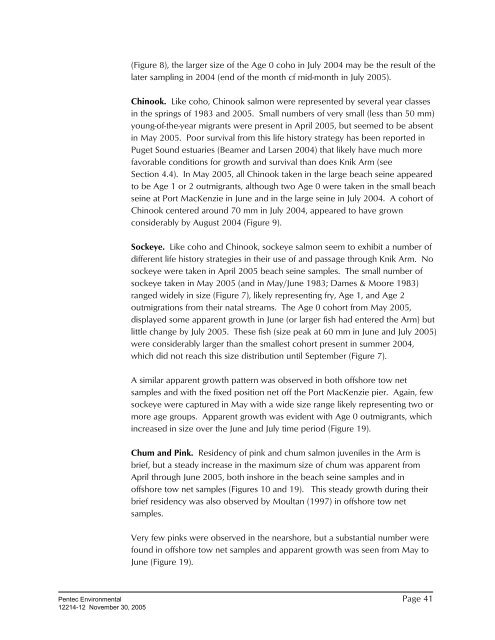Marine Fish and Benthos Studies - Knik Arm Bridge and Toll Authority
Marine Fish and Benthos Studies - Knik Arm Bridge and Toll Authority
Marine Fish and Benthos Studies - Knik Arm Bridge and Toll Authority
Create successful ePaper yourself
Turn your PDF publications into a flip-book with our unique Google optimized e-Paper software.
(Figure 8), the larger size of the Age 0 coho in July 2004 may be the result of the<br />
later sampling in 2004 (end of the month cf mid-month in July 2005).<br />
Chinook. Like coho, Chinook salmon were represented by several year classes<br />
in the springs of 1983 <strong>and</strong> 2005. Small numbers of very small (less than 50 mm)<br />
young-of-the-year migrants were present in April 2005, but seemed to be absent<br />
in May 2005. Poor survival from this life history strategy has been reported in<br />
Puget Sound estuaries (Beamer <strong>and</strong> Larsen 2004) that likely have much more<br />
favorable conditions for growth <strong>and</strong> survival than does <strong>Knik</strong> <strong>Arm</strong> (see<br />
Section 4.4). In May 2005, all Chinook taken in the large beach seine appeared<br />
to be Age 1 or 2 outmigrants, although two Age 0 were taken in the small beach<br />
seine at Port MacKenzie in June <strong>and</strong> in the large seine in July 2004. A cohort of<br />
Chinook centered around 70 mm in July 2004, appeared to have grown<br />
considerably by August 2004 (Figure 9).<br />
Sockeye. Like coho <strong>and</strong> Chinook, sockeye salmon seem to exhibit a number of<br />
different life history strategies in their use of <strong>and</strong> passage through <strong>Knik</strong> <strong>Arm</strong>. No<br />
sockeye were taken in April 2005 beach seine samples. The small number of<br />
sockeye taken in May 2005 (<strong>and</strong> in May/June 1983; Dames & Moore 1983)<br />
ranged widely in size (Figure 7), likely representing fry, Age 1, <strong>and</strong> Age 2<br />
outmigrations from their natal streams. The Age 0 cohort from May 2005,<br />
displayed some apparent growth in June (or larger fish had entered the <strong>Arm</strong>) but<br />
little change by July 2005. These fish (size peak at 60 mm in June <strong>and</strong> July 2005)<br />
were considerably larger than the smallest cohort present in summer 2004,<br />
which did not reach this size distribution until September (Figure 7).<br />
A similar apparent growth pattern was observed in both offshore tow net<br />
samples <strong>and</strong> with the fixed position net off the Port MacKenzie pier. Again, few<br />
sockeye were captured in May with a wide size range likely representing two or<br />
more age groups. Apparent growth was evident with Age 0 outmigrants, which<br />
increased in size over the June <strong>and</strong> July time period (Figure 19).<br />
Chum <strong>and</strong> Pink. Residency of pink <strong>and</strong> chum salmon juveniles in the <strong>Arm</strong> is<br />
brief, but a steady increase in the maximum size of chum was apparent from<br />
April through June 2005, both inshore in the beach seine samples <strong>and</strong> in<br />
offshore tow net samples (Figures 10 <strong>and</strong> 19). This steady growth during their<br />
brief residency was also observed by Moultan (1997) in offshore tow net<br />
samples.<br />
Very few pinks were observed in the nearshore, but a substantial number were<br />
found in offshore tow net samples <strong>and</strong> apparent growth was seen from May to<br />
June (Figure 19).<br />
Pentec Environmental Page 41<br />
12214-12 November 30, 2005
















